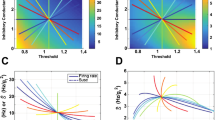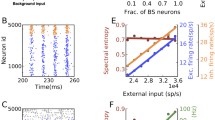Abstract
Heterogeneity of neural attributes has recently gained a lot of attention and is increasing recognized as a crucial feature in neural processing. Despite its importance, this physiological feature has traditionally been neglected in theoretical studies of cortical neural networks. Thus, there is still a lot unknown about the consequences of cellular and circuit heterogeneity in spiking neural networks. In particular, combining network or synaptic heterogeneity and intrinsic heterogeneity has yet to be considered systematically despite the fact that both are known to exist and likely have significant roles in neural network dynamics. In a canonical recurrent spiking neural network model, we study how these two forms of heterogeneity lead to different distributions of excitatory firing rates. To analytically characterize how these types of heterogeneities affect the network, we employ a dimension reduction method that relies on a combination of Monte Carlo simulations and probability density function equations. We find that the relationship between intrinsic and network heterogeneity has a strong effect on the overall level of heterogeneity of the firing rates. Specifically, this relationship can lead to amplification or attenuation of firing rate heterogeneity, and these effects depend on whether the recurrent network is firing asynchronously or rhythmically firing. These observations are captured with the aforementioned reduction method, and furthermore simpler analytic descriptions based on this dimension reduction method are developed. The final analytic descriptions provide compact and descriptive formulas for how the relationship between intrinsic and network heterogeneity determines the firing rate heterogeneity dynamics in various settings.





Similar content being viewed by others
Notes
In refractory, the other variables are governed by their ODEs
The middle 98.76 % is included, so for σ 𝜃 = 1, 𝜃∈[0.8,1.2]
Although ignoring the refractory period could be problematic for large firing rates, we emphasize that the value of our analysis is not in quantitative matching of simulations but rather for a deeper understanding of how network attributes effect the outputs. A similar calculation has been performed with the refractory period (not shown), but the asymptotic formulas are not insightful.
References
Apfaltrer, F., Ly, C., & Tranchina, D. (2006). Population density methods for stochastic neurons with realistic synaptic kinetics: firing rate dynamics and fast computational methods. Network: Computation in Neural Systems, 17, 373–418.
Börgers, C., & Kopell, N. (2003). Synchronization in networks of excitatory and inhibitory neurons with sparse, random connectivity. Neural Computation, 15(3), 509–538.
Bremaud, A., West, D., & Thomson, A. (2007). Binomial parameters differ across neocortical layers and with different classes of connections in adult rat and cat neocortex. Proceedings of the National Academy of Sciences, 104, 14134–14139.
Burton, S., Ermentrout, B., & Urban, N. (2012). Intrinsic heterogeneity in oscillatory dynamics limits correlation-induced neural synchronization. Journal of Neurophysiology, 108, 2115–2133.
Buzsáki, G., & Wang, X.J. (2012). Mechanisms of gamma oscillations. Annual Review of Neuroscience, 35, 203.
Chelaru, M., & Dragoi, V. (2008). Efficient coding in heterogeneous neuronal populations. Proceedings of the National Academy of Sciences, 105, 16344–16349.
Chow, C.C. (1998). Phase-locking in weakly heterogeneous neuronal networks. Physica D.: Nonlinear Phenomena, 118, 343–370.
Economo, M.N., & White, J.A. (2012). Membrane properties and the balance between excitation and inhibition control gamma-frequency oscillations arising from feedback inhibition. PLoS Computational Biology, 8(1), e1002,354.
Haskell, E., Nykamp, D.Q., & Tranchina, D. (2001). Population density methods for large-scale modeling of neuronal networks with realistic synaptic kinetics: cutting the dimension down to size. Network: Computation in Neural Systems, 12, 141–174.
Hermann, G., & Touboul, J. (2012). Heterogeneous connections induce oscillations in large-scale networks. Physical Review Letters, 109, 018,702.
Hertäg, L., Durstewitz, D., & Brunel, N. (2014). Analytical approximations of the firing rate of an adaptive exponential integrate and-fire neuron in the presence of synaptic noise. Frontiers in Computational Neuroscience, 8.
Hunsberger, E., Scott, M., & Eliasmith, C. (2014). The competing benefits of noise and heterogeneity in neural coding. Neural Computation, 26(8), 1600–1623.
Lengler, J., Jug, F., & Steger, A. (2013). Reliable neuronal systems: the importance of heterogeneity. PloS One, 8(12), e80,694.
Levy, R.B., & Reyes, A.D. (2012). Spatial profile of excitatory and inhibitory synaptic connectivity in mouse primary auditory cortex. The Journal of Neuroscience, 32(16), 5609–5619.
Ly, C. (2013). A principled dimension reduction method for the population density approach to modeling networks of neurons with synaptic dynamics. Neural Computation, 25, 2682–2708.
Ly, C. (2014). Dynamics of coupled noisy neural oscillators with heterogeneous phase resetting curves. SIAM Journal on Applied Dynamical Systems, 13, 1733–1755.
Ly, C., & Tranchina, D. (2009). Spike train statistics and dynamics with synaptic input from any renewal process: a population density approach. Neural Computation, 21, 360–396. doi:10.1162/neco.2008.03-08-743.
Ly, C., Middleton, J., & Doiron, B. (2012). Cellular and circuit mechanisms maintain low spike co-variability and enhance population coding in somatosensory cortex. Frontiers in Computational Neuroscience, 6, 1–26. doi:10.3389/fncom.2012.00007.
Marder, E. (2011). Variability, compensation, and modulation in neurons and circuits. Proceedings of the National Academy of Sciences, 108, 15542–15548.
Marder, E., & Goaillard, J. (2006). Variability, compensation and homeostasis in neuron and network function. Nature Reviews Neuroscience, 7, 563–574.
Markram, H., Lübke, J., Frotscher, M., Roth, A., & Sakmann, B. (1997). Physiology and anatomy of synaptic connections between thick tufted pyramidal neurones in the developing rat neocortex. The Journal of Physiology, 500, 409.
Marsat, G., & Maler, L. (2010). Neural heterogeneity and efficient population codes for communication signals. Journal of Neurophysiology, 104, 2543–2555.
Mejias, J., & Longtin, A. (2012). Optimal heterogeneity for coding in spiking neural networks. Physical Review Letters, 108, 228102-1–228102-5.
Mejias, J., & Longtin, A. (2014). Differential effects of excitatory and inhibitory heterogeneity on the gain and asynchronous state of sparse cortical networks. Frontiers in Computational Neuroscience, 8.
Mejias, J.F., Marsat, G., Bol, K., Maler, L., & Longtin, A. (2013). Learning contrast-invariant cancellation of redundant signals in neural systems. PLoS Computational Biology, 9(9), e1003,180.
Mochol, G., Hermoso-Mendizabal, A., Sakata, S., & Harris, K.D (2015). Stochastic transitions into silence cause noise correlations in cortical circuits. Proceedings of the National Academy of Sciences, 112(11), 3529–3534.
Moreno-Bote, R., & Parga, N. (2006). Auto- and crosscorrelograms for the spike response of leaky integrate-and-fire neurons with slow synapses. Physical Review Letters, 96, 028,101.
Nesse, W.H., Borisyuk, A., & Bressloff, P. (2008). Fluctuation-driven rhythmogenesis in an excitatory neuronal network with slow adaptation. Journal of Computational Neuroscience, 25, 317–333.
Nicola, W., Ly, C., & Campbell, S.A. (2015). One-dimensional population density approaches to recurrently coupled networks of neurons with noise. SIAM Journal on Applied Mathematics (in press).
Nykamp, D., & Tranchina, D. (2001). A population density approach that facilitates large-scale modeling of neural networks: extension to slow inhibitory synapses. Neural Computation, 13, 511–546.
Ostojic, S. (2014). Two types of asynchronous activity in networks of excitatory and inhibitory spiking neurons. Nature Neuroscience, 17, 594–600.
Ostojic, S., Brunel, N., & Hakim, V. (2009). Synchronization properties of networks of electrically coupled neurons in the presence of noise and heterogeneities. Journal of Computational Neuroscience, 26(3), 369–392.
Oswald, A., Doiron, B., Rinzel, J., & Reyes, A. (2009). Spatial profile and differential recruitment of gabab modulate oscillatory activity in auditory cortex. The Journal of Neuroscience, 29, 10321–10334.
Padmanabhan, K., & Urban, N. (2010). Intrinsic biophysical diversity decorrelates neuronal firing while increasing information content. Nature Neuroscience, 13, 1276–1282.
Parker, D. (2003). Variable properties in a single class of excitatory spinal synapse. The Journal of Neuroscience, 23(8), 3154–3163.
Ponce-Alvarez, A., Thiele, A., Albright, T., Stoner, G., & Deco, G. (2013). Stimulus-dependent variability and noise correlations in cortical mt neurons. Proceedings of the National Academy of Sciences, 110, 13162–13167.
Ruff, D.A., & Cohen, M.R. (2014). Attention can either increase or decrease spike count correlations in visual cortex. Nature Neuroscience, 17(11), 1591–1597.
Shamir, M., & Sompolinsky, H. (2006). Implications of neuronal diversity on population coding. Neural Computation, 18, 1951–1986.
Strogatz, S.H., & Mirollo, R.E. (1991). Stability of incoherence in a population of coupled oscillators. Journal of Statistical Physics, 63, 613–635.
Tripathy, S., Padmanabhan, K., Gerkin, R., & Urban, N. (2013). Intermediate intrinsic diversity enhances neural population coding. Proceedings of the National Academy of Sciences, 110, 8248–8253.
Wang, X.J. (2010). Neurophysiological and computational principles of cortical rhythms in cognition. Physiological Reviews, 90, 1195–1268.
Xue, M., Atallah, B.V., & Scanziani, M. (2014). Equalizing excitation-inhibition ratios across visual cortical neurons. Nature, 511, 596–600.
Yim, M., Aertsen, A., & Rotter, S. (2013). Impact of intrinsic biophysical diversity on the activity of spiking neurons. Physical Review E, 87, 032710.
Acknowledgments
We thank Gary Marsat and Brent Doiron for enlightening conversations, and Brent Doiron for providing feedback on the manuscript. This work was supported by a grant from the Simons Foundation (#355173, Cheng Ly).
Conflict of interest
The author declares that he has no conflict of interest.
Author information
Authors and Affiliations
Corresponding author
Additional information
Action Editor: Brent Doiron
Appendix
Appendix
Given two vectors 𝜃 (intrinsic heterogeneity) and q (network heterogeneity), we can generate a new pair of vectors (of the same size) that have any desired correlation coefficient ϱ∈(−1,1). In this paper, we choose to keep q fixed and generate a new vector 𝜗 that has the same sample mean (μ(𝜃)) and sample standard deviation (σ(𝜃)) of 𝜃. Note that there are infinitely many ways to generate two such vectors if we only require that the mean and standard deviation of the new vectors be equal to the original statistics of the vector. The algorithm we use is as follows.
-
INPUTS: (q, 𝜃, ϱ)
-
Set φ= cos−1(ϱ)
-
Shift input vectors so they have zero mean:
q 0 = q−μ(q)
𝜃 0 = 𝜃−μ(𝜃).
-
Calculate orthogonal complement to q 0:
\(\mathbf {z}=\boldsymbol {\theta }_{0}-\frac {\mathbf {q}_{0}\cdot \boldsymbol {\theta }_{0}}{\|\mathbf {q}_{0}\|^{2}}\mathbf {q}_{0}\)
-
Create unit vectors out of q 0 and z:
\(\tilde {\mathbf {q}}=\mathbf {q}_{0}/\|\mathbf {q}_{0}\|\), \(\tilde {\mathbf {z}}=\mathbf {z}/\|\mathbf {z}\|\)
-
Create vector with prescribed correlation and zero mean:
\(\hat {\boldsymbol {\theta }}=\cos (\varphi )\tilde {\mathbf {q}}+\sin (\varphi )\tilde {\mathbf {z}}\)
-
Set \(\boldsymbol {\vartheta }=\frac {\sigma (\boldsymbol {\theta })}{\sigma (\hat {\boldsymbol {\theta }})}\hat {\boldsymbol {\theta }}+\mu (\boldsymbol {\theta })\)
-
OUTPUT: 𝜗, where correlation coefficient of 𝜗 and q is ϱ, μ(𝜗) = μ(𝜃), and σ(𝜗) = σ(𝜃).
Rights and permissions
About this article
Cite this article
Ly, C. Firing rate dynamics in recurrent spiking neural networks with intrinsic and network heterogeneity. J Comput Neurosci 39, 311–327 (2015). https://doi.org/10.1007/s10827-015-0578-0
Received:
Revised:
Accepted:
Published:
Issue Date:
DOI: https://doi.org/10.1007/s10827-015-0578-0




